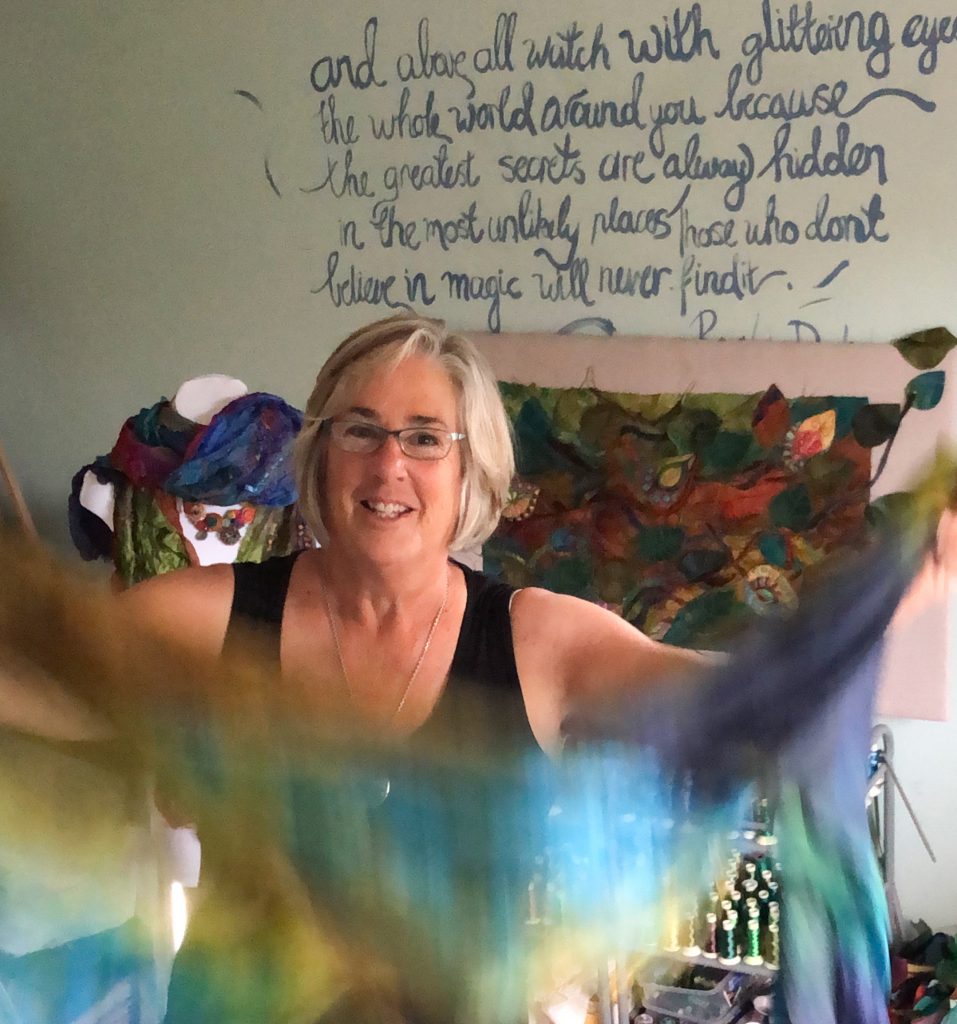Michelle Mischkulnig Textile Artist
Expand on your quote, “I am passionate about my art, created with joy”.
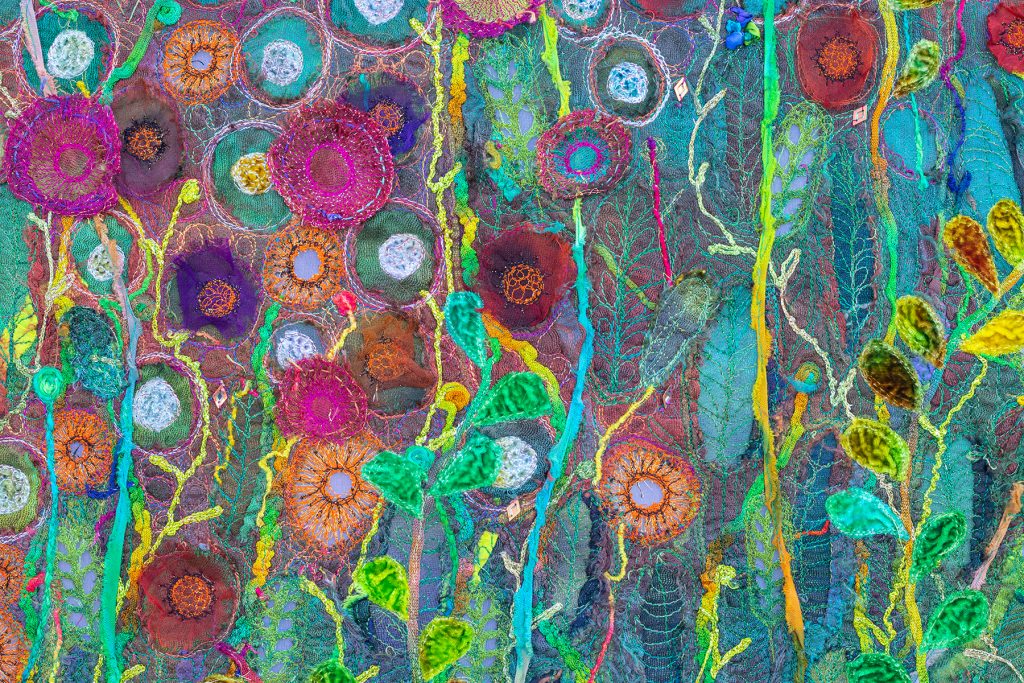
Ramblers Garden 2, Detail
I love starting each day with the sense of anticipation of where my creativity will lead me today, what adventures lay ahead. My textile art is about colour and movement, it is about the “good stuff in life”. Every layer and every stitch tell the story of joy and the magic that can be found in the everyday if we open our minds to the possibility.
Joy is a spontaneous emotion which is given, taken and shared. It brings great pleasure to our lives, it makes us smile.
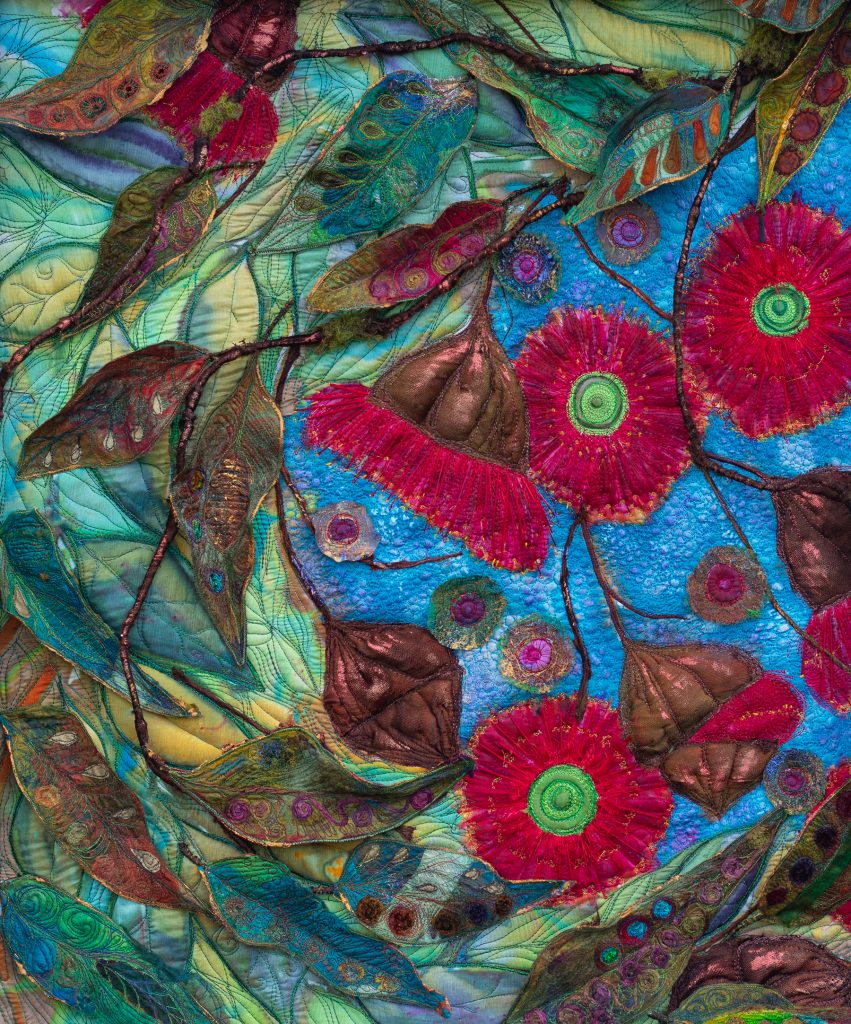
Gum Blossoms, 40 cm x 55 cm, fabric and fibre
All, of the art that I create comes from the heart. It is organic and unstructured; it is moments captured in layers of fabric and fibre; it is my conversation with the viewer, I am sharing my joy and my passion for all that I make.
To breathe life into an art work with colour, movement texture and stitch is uplifting for me as an artist. I am not depicting reality, but I am sharing with you my song whose lyrics are the stitches which depict my memories of landscapes, music, food, dance, sunsets, gardens, cold droplets of water, salty skin and white cockatoos on the horizon. Each art work I create resonates my joy in leading a privileged life of being a maker.
Take a piece of work, done in machine embroidery, discuss the stages involved in this piece, from inspiration to completion.
This textile art work was created after a holiday with my 18-month-old granddaughter at the beach. In her language the beach became known as “bubbles” and the birds “toit toits”, the simplicity of these names and the joy of each spoken word was my inspiration.
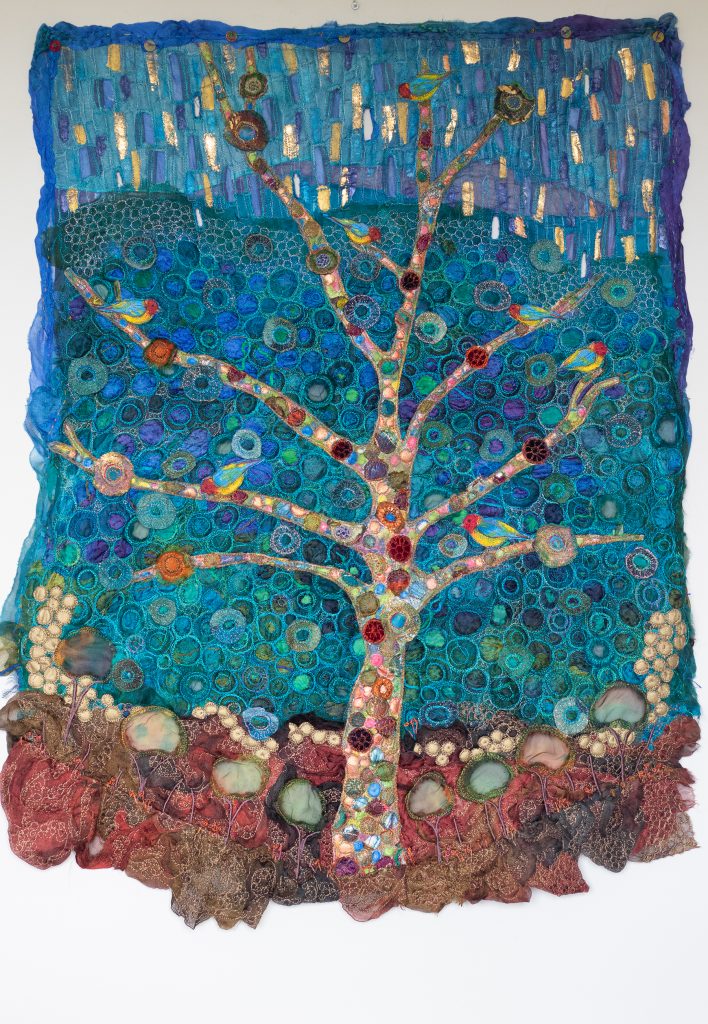
Bubbles and Toit Toits, fabric and fibre
In this textile art work there are many layers of hand dyed silk fabric which has an amazing drape and lustre, these layers have been covered over with single piece of hand dyed silk organza. I have free motion stitched all these layers in bubble shapes and then cut back through the layers to reveal the texture and colours underneath giving the art work movement and depth. To stitch the random bubble shapes, I have used different coloured embroidery and metallic threads.
The amount of stitching around the outside of the bubble shape flattens this space and in doing so elevates the bubble shape. Some of the bubbles are cut out through all the layers creating a negative space which is then backed with a sheer organza, some bubbles are 3D shapes and are attached to the surface.
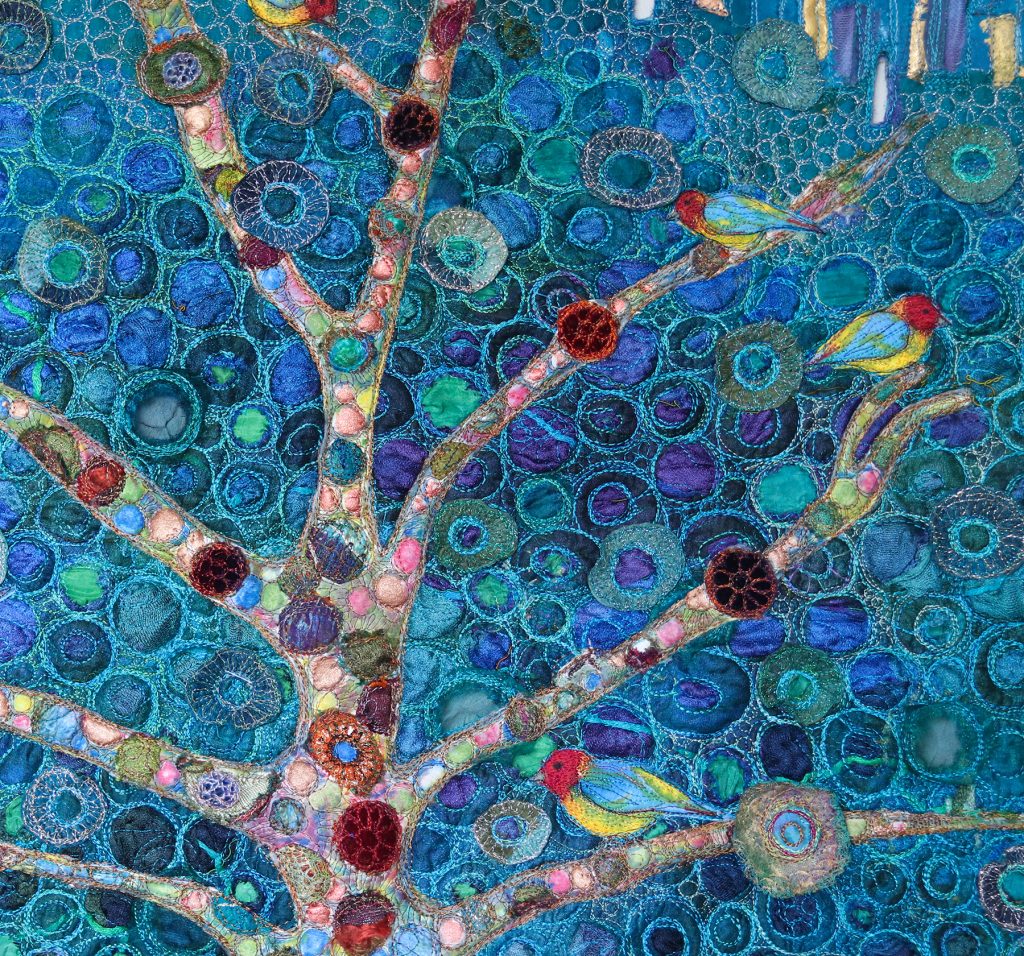 Bubbles and Toit Toits, fabric and fibre, detail
Bubbles and Toit Toits, fabric and fibre, detail
The tree trunk is raised higher than the background by using a thick polyester wadding. The trunk is made separately from the body of the art work. I have used a fabric that behaves like paper which has been embellished with many interesting textures and elements, then the background of the tree trunk without any embellishing was painted with fabric markers. The trunk was then attached to the body of the art work with many stitches and three-dimensional flower shapes stitched the branches.
The flowers are made, out of a variety of materials such as silk organza and silk velvet, they were stitched individually before attaching them to the branches.
The sky is one layer of silk fabric which has been stitched and cut back, some of the cut areas are left open and some have a backing behind them. I have also used small amounts of gold foil and gold paint in the sky.
The bottom of the picture is based around the earth and trees which are free motion embroidered, I have also has cut the tree foliage out and backed with a sheer silk organza.
Each “toit toit” was independently free motion stitched in lovely colours and then cut out and stitched to the background.
It is a completely organic art work with beautiful tattered soft edges which doesn’t give you an end or a beginning.
How do you control colour in your work?
Wow! this question makes me think—do I control it? I absolutely love accidental effects, I do not consciously consider controlling my colour. Colour is intuitive for me. You just dive into it, love it, don’t fear it, don’t, procrastinate over it. Just get caught up in the wild splashes and exuberance of when colours flow together. I am self-taught and I have not attended any workshops in colour, but my tertiary education was in textile design where we did work with colourways, much to my frustration.
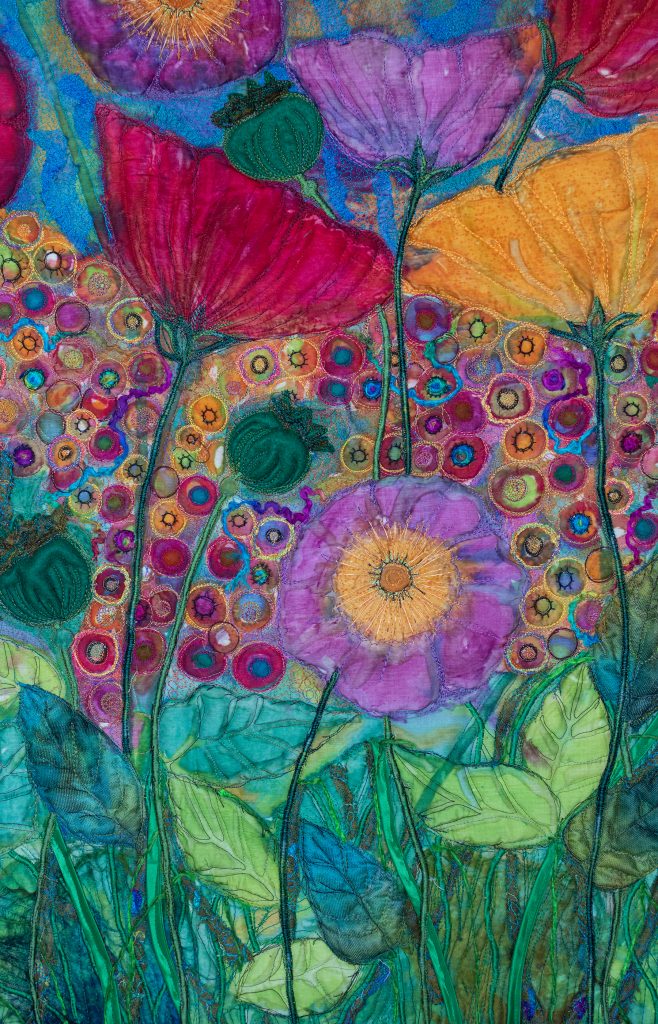
Poppies, 40cm x 55cm, fabric and fibre
I do not use a discipline or rule to control how I use colour. It’s just a sense of balance when I look at the art work. I am not afraid to experiment with colour, if it is iniquitous, I just add some new layers of fabric to cover it, cut it out or stitch over the top. When I teach, I ask the students not to procrastinate over colours just go with your gut feeling, don’t fall prisoner to colour rules. I do not intentionally control my colour, I am not aware of any actions that I take deliberately, but deeply ingrained there must be something subconsciously influencing how I use it.
You have done several pieces, that have led to acquisitions. Take one and discuss?
How the piece stated?
The brief for this art work was a framed wall piece of 60 cm x 70 cm the subject is a garden. An art work that I hoped would speak to women in a breast cancer waiting room, one which will bring them calm, which will make them smile and which they can look at for long time spans and discover different features.
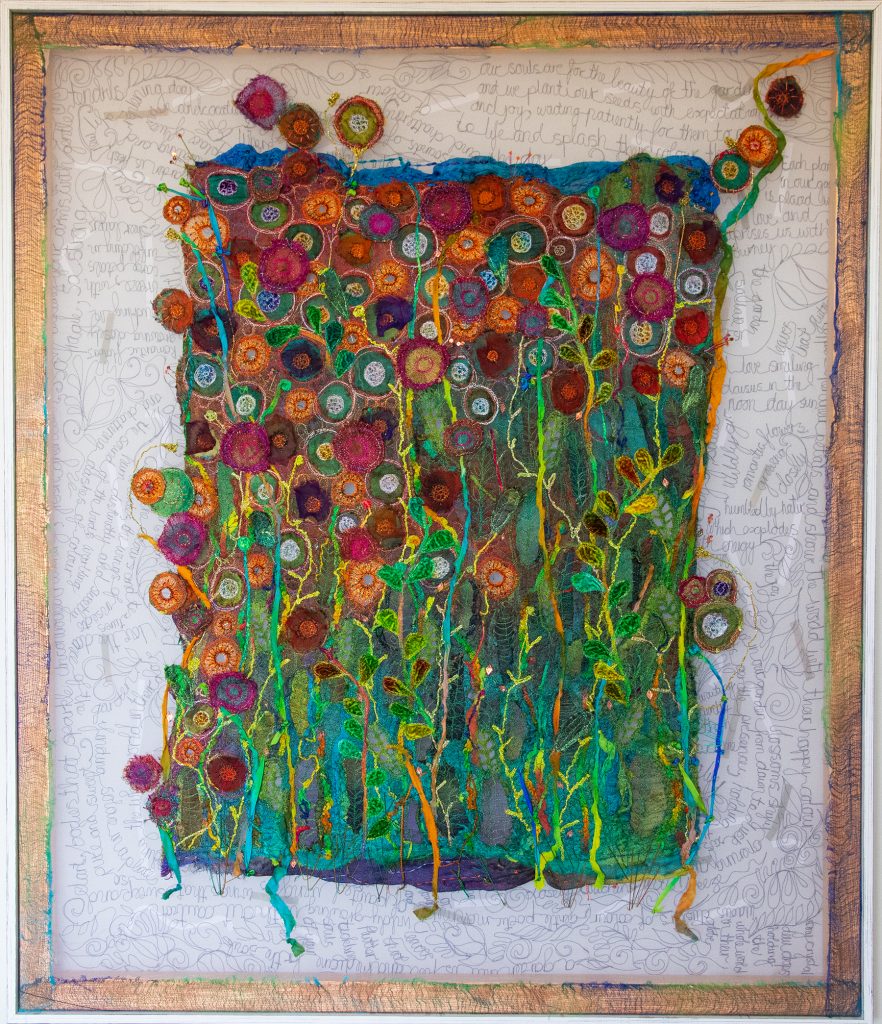 The ramblers garden 60 cm x 70 cm, fabric and fibre
The ramblers garden 60 cm x 70 cm, fabric and fibre
The importance of this acquisition for a career.
The importance to my career was minimal, the importance to me as an artist and person is ongoing. I have had contact with women who have spent many hours in that waiting room finding calm and comfort in my art work and as an artist what more could you want.
Can you explain your involvement with Bernina?
I have owned a Bernina sewing machine since I was 21 years old and that is a long time now. I still own that, particular machine and she is beautiful, my grandmother who was a dress maker also owned a Bernina sewing machine.
They are fantastic machines, real workhorses; my sewing machines can run for 6 -8 hours a day though all thicknesses and terrains. I had used my three Berninas—all around 35 years—old through my career. About four years ago I linked up with Bernina and upgraded to a modern machine.
I tend fly under the radar of most corporate and textile entities. I do not enter quilt shows or belong to quilting groups, so Bernina had not heard of me and seemed really delighted when they did and saw my art works.
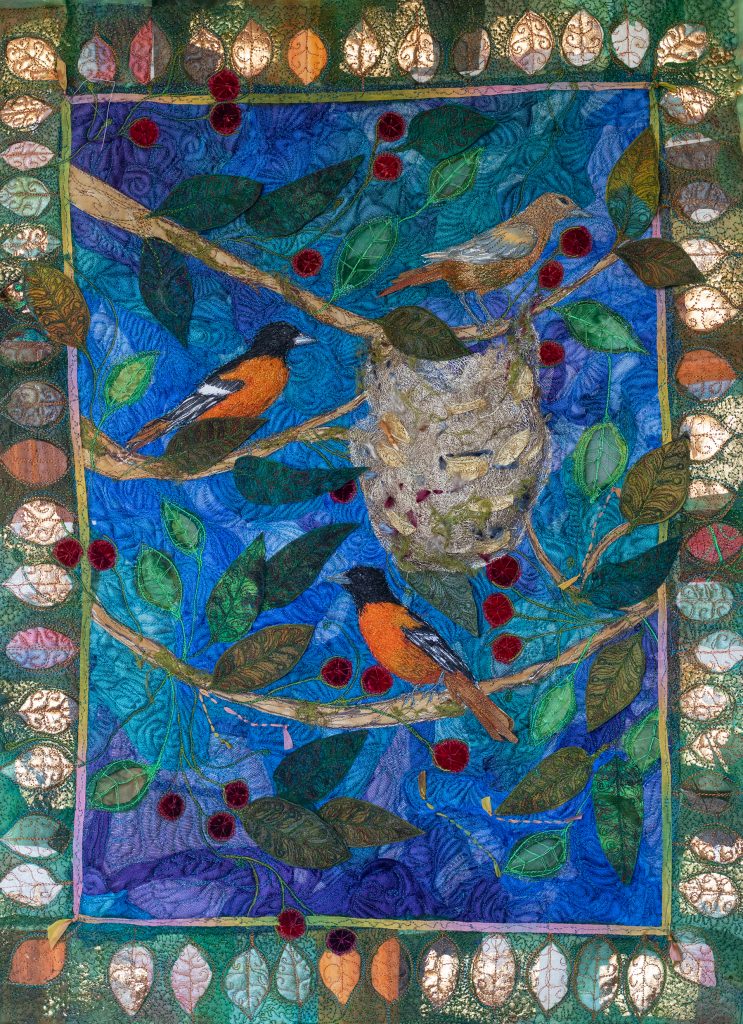
Beginnings, 45 cm x 70 cm, fabric and fibre
They are very much a family organisation and took me into their fold. I started writing blogs for their international webpage. In these blogs I shared with the reader how I use the machine and what possibilities there are. I did this through completing various projects. Although I enjoyed the experience of writing the blog it took many hours of my time which was increasingly becoming scarce. After around 12 months it was time to give it away.
In 2018 Bernina asked me to be their Guru. This was an amazing experience, travelling to shows in Brisbane and Sydney and my own home town Melbourne. What I gained from this involvement was meeting so many creative and interesting people. I talked and talked and demonstrated free motion embroidery on large art works, people were fascinated. In talking to people, I learnt that many, many people say they do not feel they are creative. I would disagree with them as I believe everybody is creative. it has endless forms. My relationship continues with Bernina and my art life revolves around my trusty machine.
How important is a good sewing machine to your work?
As you can tell from the above answer a good sewing machine is essential, but it doesn’t need to be big and fancy. It needs purr through a big workload, it needs to put up with endless textures and expectations, it needs to go fast and smooth when my foot is down. I only know two speeds on my sewing machine which are flat out and stop.
What are three functions that you want on your sewing machine and why?
Ability to free motion stitch—because that is what I do all day in my work room. Without that it would not be me.
Straight stitch—it is my most used stitch and without it I couldn’t draw with the needle.
Have a thread cutter—because I am very lazy with cutting of loose ends, this is a most spectacular function.
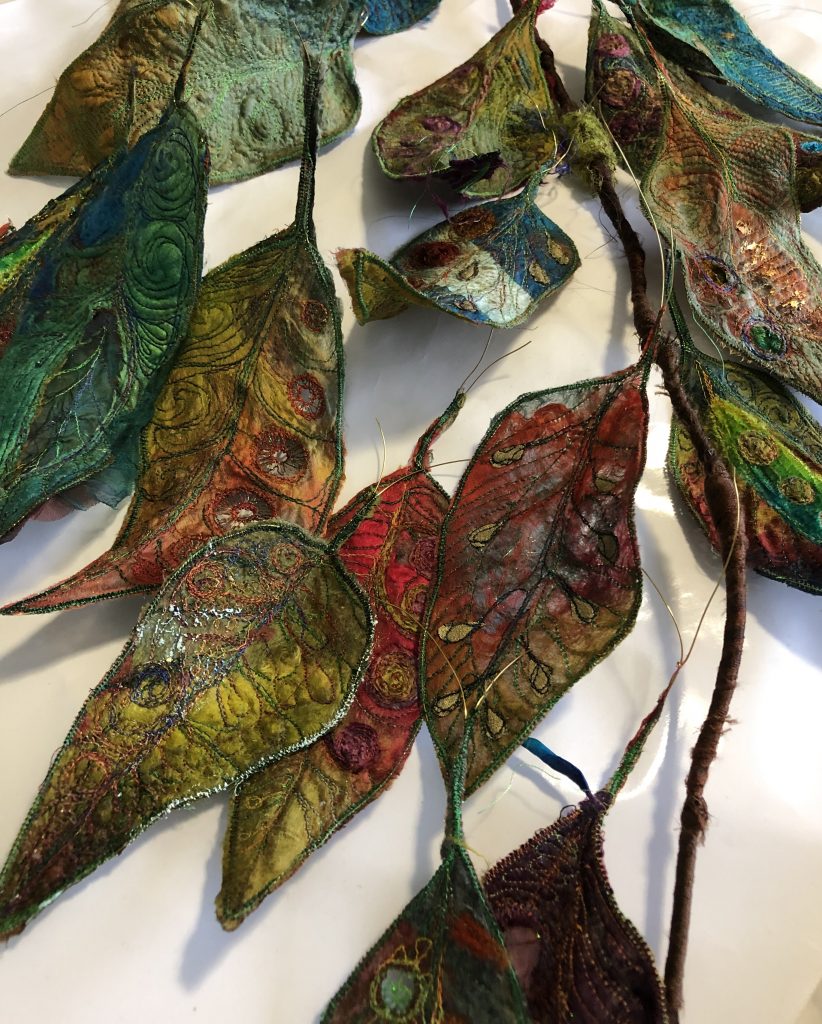
Making leaves, fabric and fibre
Discuss the importance of gardens both to you and your art.
Here I won’t discuss the importance but I will share with you some words about the garden that I use in my book, this will help you understand their meaning to me.
Luscious clusters of colours, gentle poetic movement of painted wings, wings that sweep and dart, bodies that sparkle.
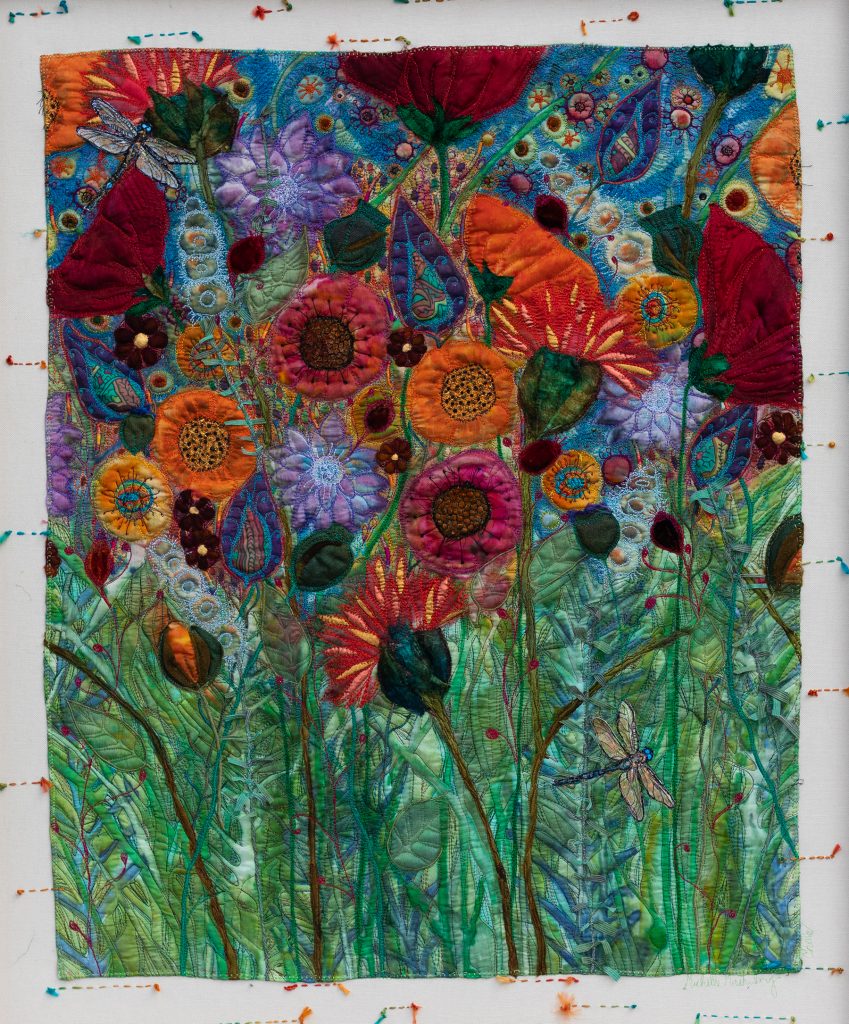
The Gardeners Place, 69 x79 cm, fabric and fibre
A music so perfect, so clear only you can hear it. The melody lingers long into the twilight hours. The garden is a place that always acknowledges a burst of vibrancy, which in turn ignites all the senses and brings new beginnings. Endearing and uplifting fragrances capture memories and weave through our soul, the scents that dance long into the evening air.
Uncontrolled reaching, fresh green buds, so fragile, so strong, tickling your arms with gentle tendrils. Wildly growing without caution or fear through cracks and dry rocks, river pebbles, relentless in their task to replenish. Tiny crystal dew drops holding the whole world in their globe, so unobtrusive, so gentle, the garden that is food and medicine for the soul.
I love the smiling daisies nodding in the noonday sun, finding solace in a place so pure and sweet. Humbled by nature which explodes with energy. Poppies open their petals and shower the world with their happy colour; blossoms shyly opening and trumpeting a new season. The joy of solace in our gardens at dawn or dusk, as watching the colours change, we witness its gentle presence, holding these moments in our thoughts.
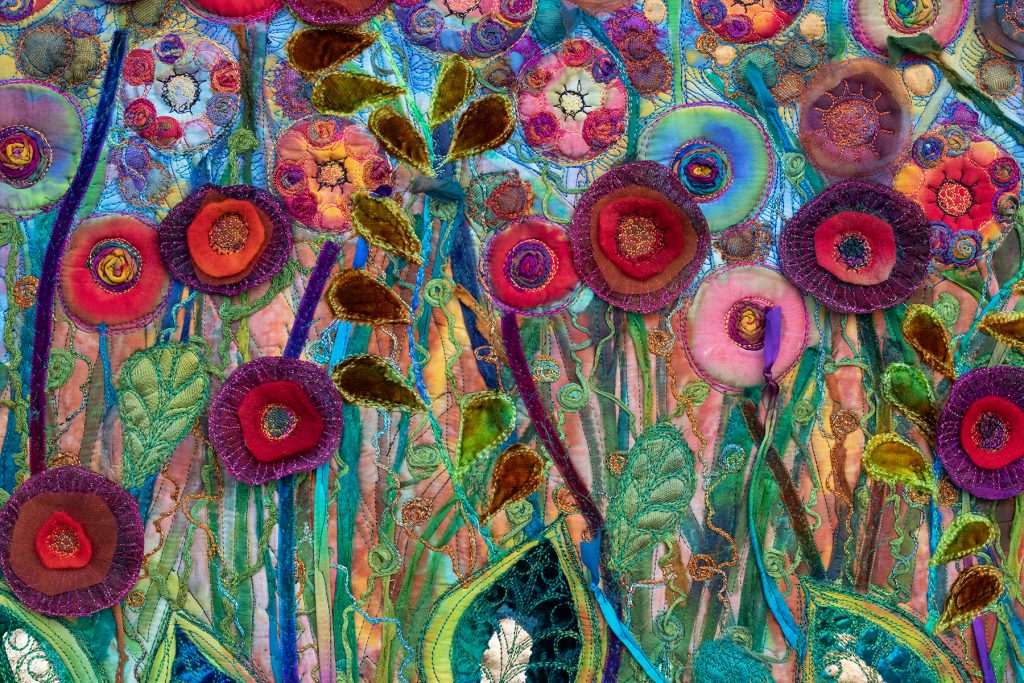
The Garden Party, fabric and fibre, detail
Our souls are hungry for the beauty of the garden, and we plant our seeds with expectation and joy, waiting patiently for them to come to life and splash their colour throughout our day. Each plant in our garden is placed with love and surprises us with its journey. Romantic flowers growing, closely touching in the breeze, with large petals unfolding in sheer layers.
I love the dance of the garden when all the colours and textures come together, the wings of insects hum distinctly and sweetly, the sound of the birds, warbling and chattering dashes of colour. The garden is a continual evolution of blush and texture where daring flowers bloom and shy ones gingerly lift their heads to the sun. Where leaves unfold into interesting shapes and fall to create abstract designs along the path. The garden is fresh new life, regeneration and replenishing decay, a place of creativity and wonder.
On a completely different angle take one of your works from your Old Cities series and discuss the work?
Oh! I do love Old Cities. This passion came from visiting Spain, Switzerland and Austria but predominantly Spain. I am completely drawn to cobblestone alleyways. Old Doors which hold secrets, steps worn down by pilgrims’ feet, keys and padlocks, sounds of hoofs.
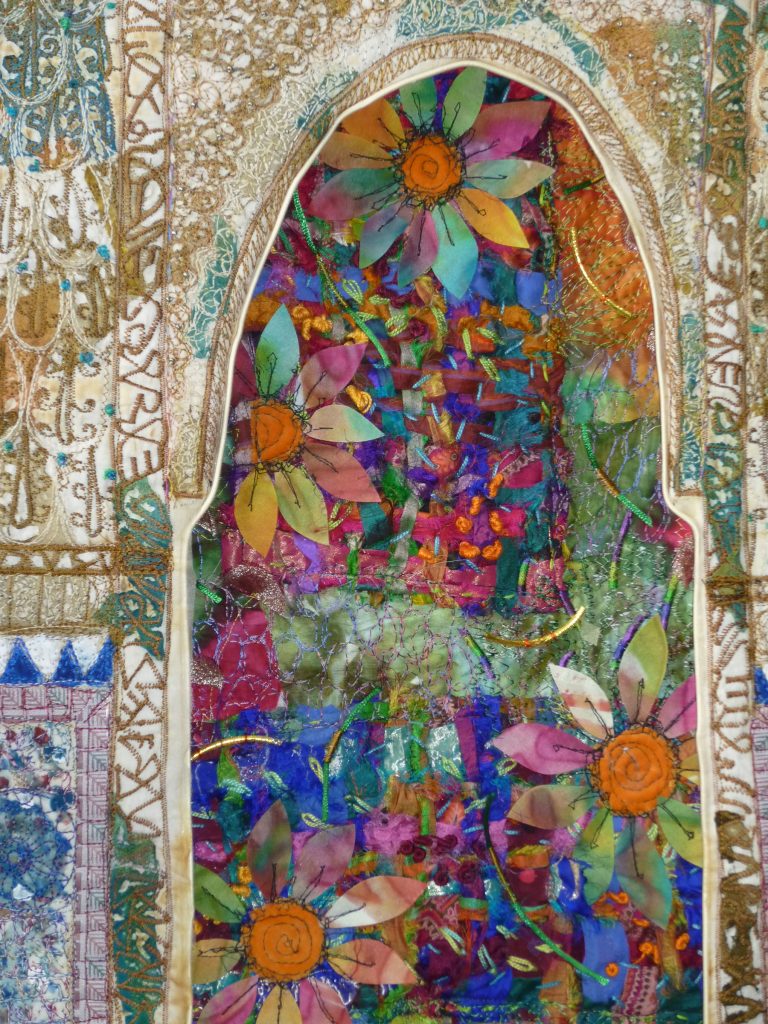
Alhambra 1, 30 cm x 40 cm, fabric and fibre
In this art work I have tried to capture in a collage technique a feeling of Old Cities. The doors, the keys, tapestries, weathered walls, stories that they hold and the beauty of Old Cities.
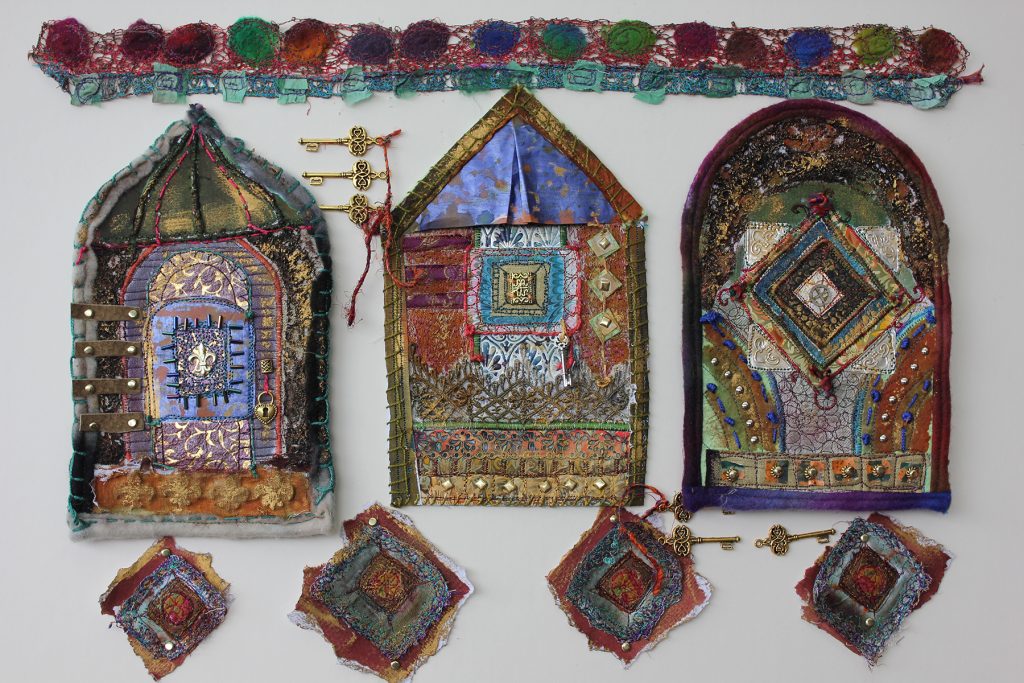
Old city doors 50cm x 30cm, fabric and fibre
Thinking of the colours and forms, it is not a depiction of any city in particular just snapshots captured in my mind.
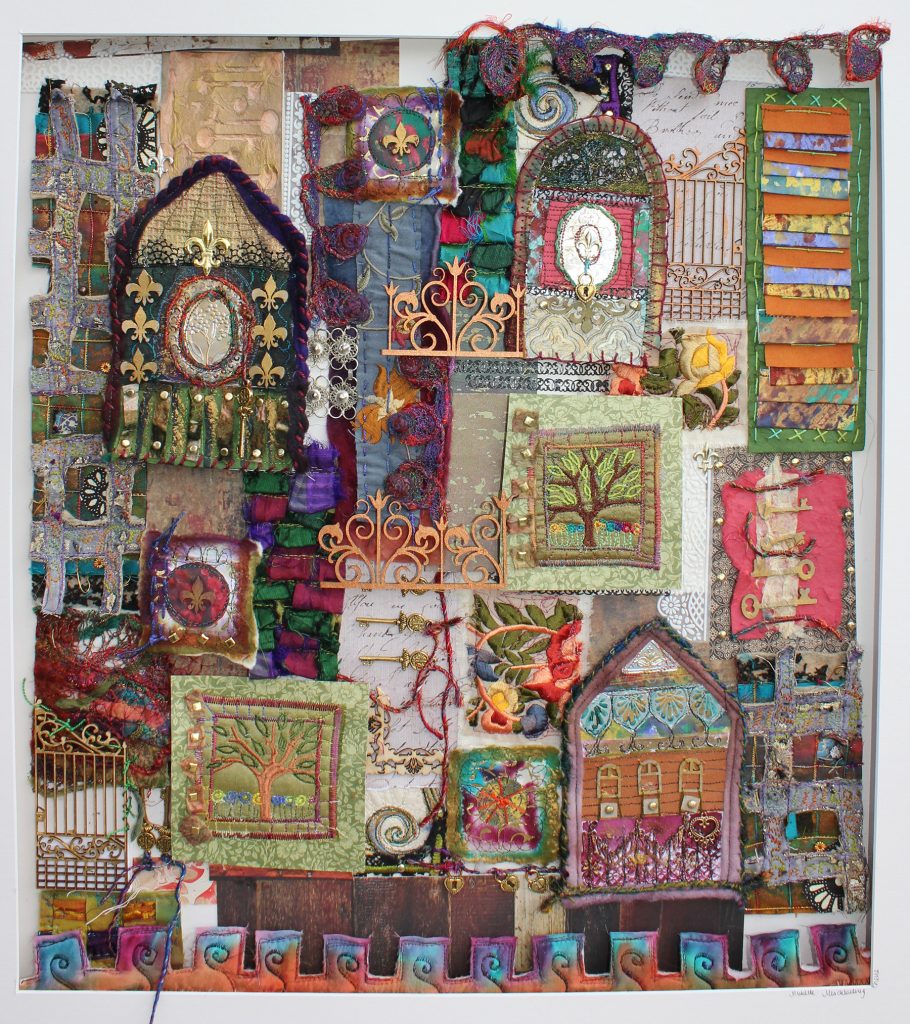
Old city memories 35cm x 45cm, fabric and fibre
How have you integrated leaves into your work – especially colour that is not always associated with leaves?
Leaves change their colour and shape depending on the light, shade, the angle and distance you are appraising them from, their movement. They change colour and shape when you pluck them from their stems, when you bruise them, when you feel their texture. I adore leaves and stitching them in many different ways and materials to add to my textile art works.
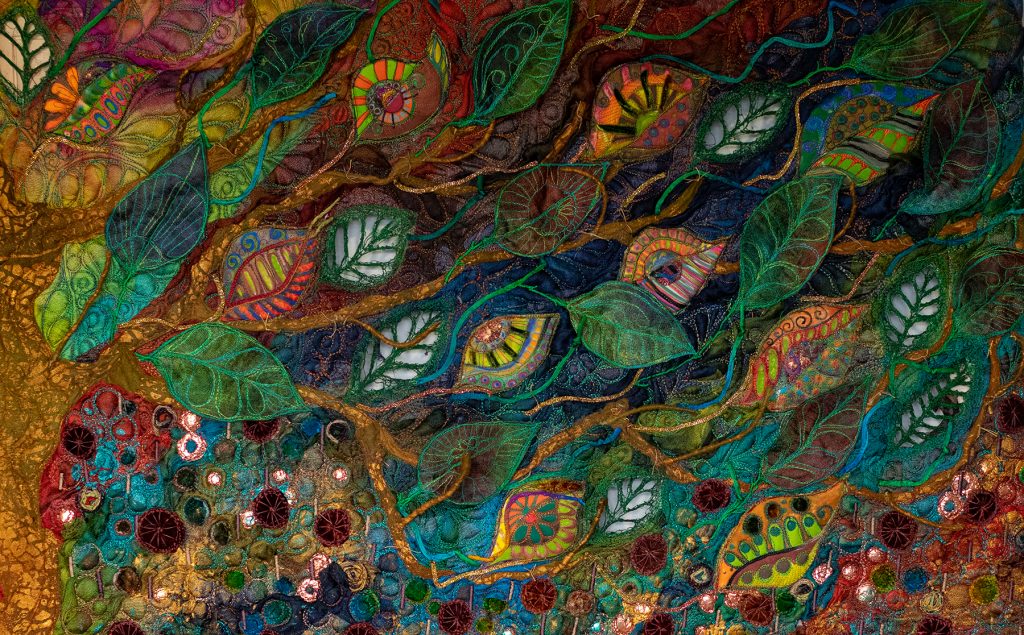
Twilring Leaves 80 cm x 40 cm, fabric and fibre
I often fashion the leaves with layers of fabric or fibre or both, producing these leaves to be a 3D element of the finished piece. Colour is in the eye of the beholder, yes leaves are mainly green but think of all those colours captured in Autumn leaves or leaves that fall to the ground in the hot sun. Think of the colours as they sparkle in the sunlight or the marks left by a caterpillar munching on them. The colours I use in my leaves vary depending on the body of the art work and my love of colour.
You do classes – discuss two things your students have taught you.
Just two things thats hard. They have taught me more life’s lessons than textile lessons.
That you never know the stories that people carry, both sad and happy they are willing to share. I love to listen.
That a group of creatives in a room for a number of days are supportive, compassionate, humorous and great fun.
While we are coping with the Corona Virus, how important will creative stitch be to you and others you know?
Creative stitch is enormously important to me during the coronavirus. It is my normality, my routine, it keeps me present in the moment, it stills my mind.
I have many followers on FaceBook who look forward to my posts, they say that they bring them joy, a little bit of magic, which is so important right now.
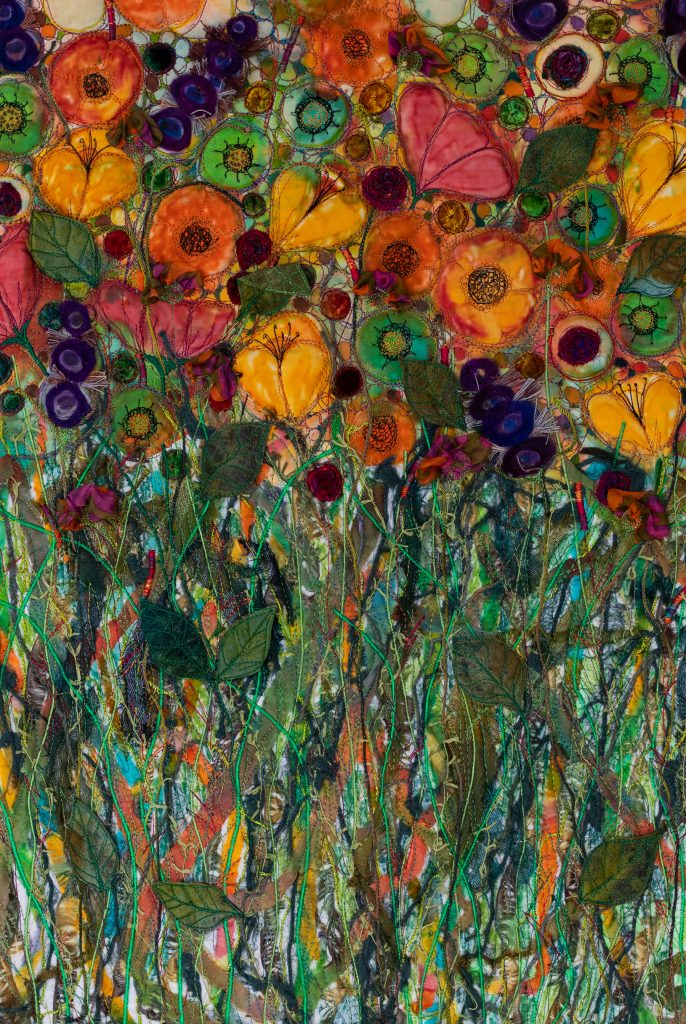 Spring, 35cm x 50cm, fabric and fibre
Spring, 35cm x 50cm, fabric and fibre
I have set up a FaceBook group for people who create and feel isolated and it is so wonderful to see these people from all around the world enjoying each other’s company and supporting each other through stitch and conversation.
I still look forward every day to filling the day with making and will continue to do this. It may be at a slower pace than what it has been in the past. The galleries I supply are no longer open and the exhibitions I have prepared for in various places around the world and Australia are now cancelled, so are most of my teaching engagements for the year. I have to believe we will come out of this and the world will need more than before beautiful things to make people smile and feel happy.
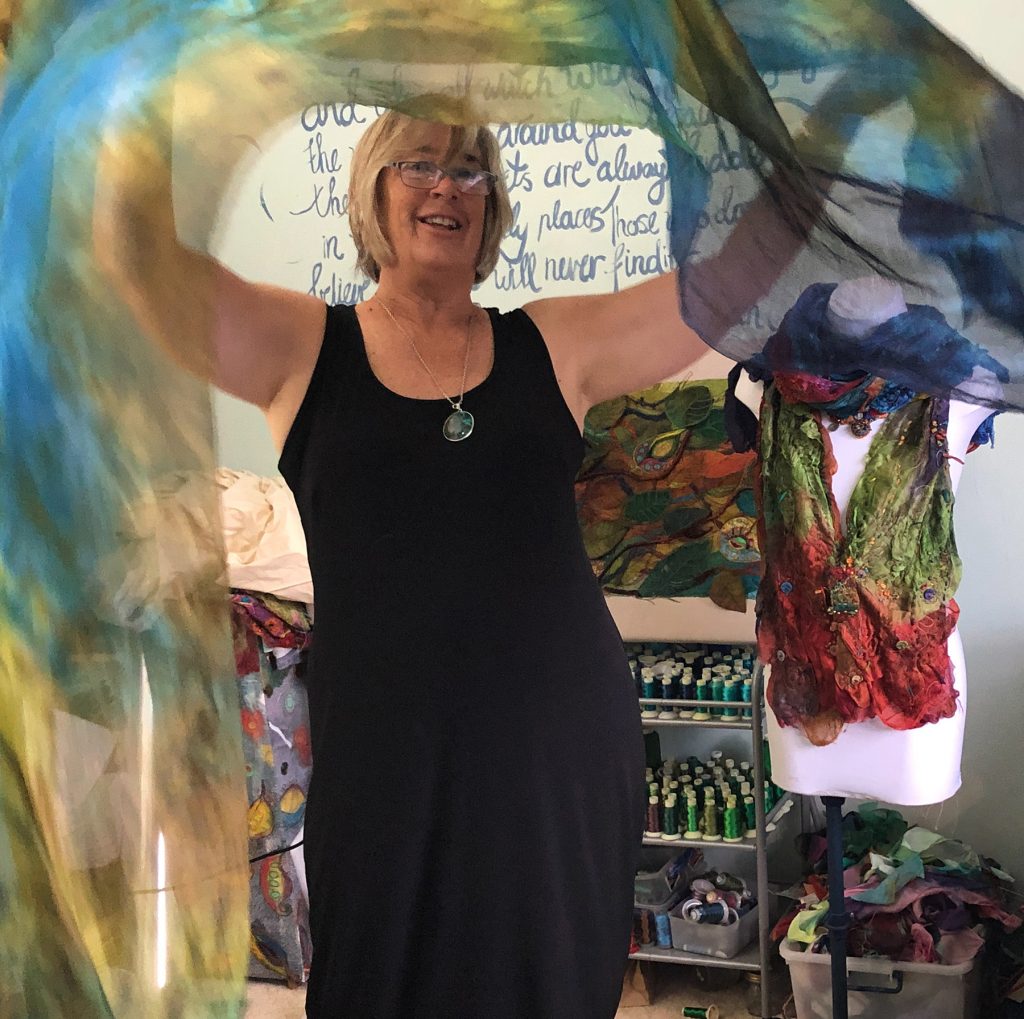
Contact:
Michelle Mischkulnig
chelletextiles@optusnet.com.au
https://blog.bernina.com/en/author/chelle/
Deborah Blakeley, Melbourne, Australia
Interview by Deborah Blakeley, April 2020
Think a colleague or friend could benefit from this interview?
Knowledge is one of the biggest assets in any business. So why not forward this on to your friends and colleagues so they too can start taking advantage of the insightful information the artist has given?
Other artists you may be interested in:


